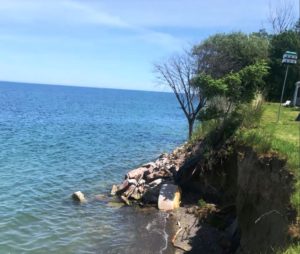Back in June 15, 2019 issue of REVITALIZATION, we announced the launch of New York state’s Lake Ontario Resiliency and Economic Development Initiative (REDI).
Now, on October 23, 2019, the money has started flowing, as Governor Andrew M. Cuomo announced $43 million for Monroe County $41 million for Wayne County to fund 43 resilience projects there, plus another $49 million to advance 20 projects in Niagara and Orleans counties.
Environmental Facilities Corporation Acting President, CEO and General Counsel Maureen Coleman said, “Governor Cuomo has made New York a leader in critical water infrastructure investments. Green infrastructure provides many benefits to communities in addition to alleviating flooding: filtering pollutants, recharging aquifers, rivers and streams, restoring habitat, cooling the surrounding environment, reducing air pollution, and decreasing energy usage. Governor Cuomo’s announcement today is a crucial step to making communities across the Empire State resilient in the face of climate change, and helping them prepare for a sustainable future.”
Identified by the communities and evaluated by state agency experts, the projects address both immediate and long-term resiliency needs, enhance economic development, protect critical infrastructure, incorporate green, natural, or nature-based features, and will help sustainably rebuild and enhance communities along the Lake Ontario and the St. Lawrence River shorelines. Additional projects in the REDI regions will be announced shortly.
“To respond to the challenges faced by New Yorkers on the Lake Ontario and St. Lawrence River shorelines, I called on 11 state agencies to mobilize their expertise and support local communities and help to implement actions that will create long-term sustainability,” Governor Cuomo said. “These critical projects will realize the State’s vision to sustainably protect and enhance the region’s infrastructure, habitats, and local economies. Working together, New York State agency experts and local stakeholders zeroed in on 63 projects in these counties to serve as the crucial next step to helping these shoreline communities become whole again, as well as more resilient and economically vibrant.”
Five REDI regions, comprising eight counties (Niagara and Orleans, Monroe, Wayne, Cayuga and Oswego, and Jefferson and St. Lawrence) were established to identify local priorities, at-risk infrastructure and other assets, and public safety concerns. The REDI Commission allocated $300 million to the effort: $20 million for homeowner assistance, $30 million to improve the resiliency of businesses, and $15 million toward a regional dredging effort that will benefit each of the eight counties. The remaining balance, $235 million, has been allocated towards local and regional projects that advance and exemplify the REDI mission.
“Communities along Lake Ontario and the St. Lawrence River have faced tremendous challenges in recent years. That’s why we have taken aggressive action to help local governments, businesses, and homeowners with state support to improve resiliency and address the impact of flooding,” said Lieutenant Governor Kathy Hochul. “This targeted funding for projects in Monroe and Wayne counties will address infrastructure needs to ensure sustainability long-term. These critical efforts will help to combat devastation from extreme weather events, strengthen our economy, and enhance quality of life for residents.”
To identify projects, over the course of three months, REDI organized 25 stakeholder and community meetings and workshops with hundreds of local residents, convened more than 15 planning committee meetings, and directed New York State agency and engineering experts to expend thousands of hours to evaluate more than 500 projects proposed by communities. The projects comprise a range of at-risk assets, including shoreline stabilization, public health and safety, critical water and wastewater infrastructure, marinas and harbors, and land loss/value, among other priorities, with an emphasis on natural or nature-based features and green infrastructure.
HCR Commissioner RuthAnne Visnauskas said, “As communities along Lake Ontario’s shoreline continue to recover from the effects of devastating floods, it’s vital that we make the types of investments that will bolster infrastructure for the long-term. By improving resiliency across flood prone regions, we can ensure recovery efforts for homeowners and businesses will be sustainable.”
For each project, multi-jurisdictional permit reviews, and any associated environmental reviews, will be needed prior to any final determination to proceed. In order to build resilience, reduce the risk of future property damage, and minimize habitat impacts, the Department of Environmental Conservation (DEC) has compiled general guidelines for coastal design and development projects. These guidelines include technical data, regulatory guidance, best practices, and available resources for development along the dynamic shorelines of the Great Lakes and St. Lawrence River. This comprehensive technical and permitting information to help expedite the permitting process is available on the REDI guidance webpage.
Empire State Development Acting Commissioner, President and CEO-Designate and REDI Commission Co-Chair Eric Gertler said, “Rebuilding with greater resilience is more important than ever given the new environmental reality of increasing water levels along Lake Ontario and the St. Lawrence River. The REDI Commission is working hard to ensure that communities not only recover more quickly from destructive weather events, but are stronger and better prepared for the future, unfortunate effects of climate change.”
To further address the challenges posed by high water levels, in addition to the county-specific projects announced today, Governor Cuomo announced an eight-county $15 million Regional Dredging effort, to sustainably maintain safe navigation channels to harbors and bays along Lake Ontario and the St. Lawrence River. These channels are critical to the vitality of recreational and commercial boating, which generate an estimated over 1,000 jobs across the region.
Dredged sediments appropriate for beneficial re-use may be employed in ecosystem restoration or erosion management projects, with likely benefits to habitat, water quality, and beach nourishment.
Thirty million dollars of REDI funds have been set aside for the Lake Ontario Business Resiliency Program, which will be administered by Empire State Development (ESD). Under the program, ESD will provide grants of up to $200,000 to eligible applicants who experienced direct physical flood-related damage due to the high-water levels from Lake Ontario and the St. Lawrence River in 2019. Eligible applicant types are expected to include small businesses, not-for-profit organizations, farms, homeowners’ associations and owners of rental properties.
Under the Program, grants will be available to reimburse up to 50 percent of an eligible applicant’s capital improvement project that is designed to strengthen their business against impacts of future flooding and make their business more resilient in nature. Each project must also receive matching support from a local government totaling at least 5 percent of state funds to be awarded under the Program. Local contributions are expected to include, but not be limited to, certain tax exemptions offered by Industrial Development Authorities, local government waivers of the costs of ordinarily due permits and fees, and direct expenditures by local governments on project-related infrastructure. To be notified when the Lake Ontario Business Resiliency Program is open for applications, please complete the recently published intake form here.
In addition to the projects announced today, the State Department of Homes and Community Renewal (HCR) is administering a 2019 Individual Homeowner Assistance Program that will provide residents in the impacted eight-county region up to $50,000 in state funding to help offset damages to their primary residences. The homeowner application period is open until Oct. 31, 2019, and more information about applying can be found here.
Rochester Mayor Lovely Warren said, “I’m grateful to Governor Cuomo for his continued leadership in addressing climate change. Today’s announcement in particular shows that the Governor is committed to helping Rochester overcome the challenges we face from rising lake levels.”
Many of the REDI projects incorporate green infrastructure or natural or nature-based features and will be designed to have no or minimal environmental impact. Green infrastructure is a cost-effective, environmentally beneficial, and resilient approach to managing wet weather impacts. While conventional stormwater infrastructure, such as piped drainage and water treatment systems, are designed to move stormwater away from the built environment, green infrastructure reduces and treats stormwater at its source while delivering environmental and economic benefits without destroying habitat or disrupting natural features.
Gil C. Quiniones, President and CEO, New York Power Authority, said, “The great Lake Ontario and the St. Lawrence River are vital to our state’s economy. We, at NYPA, are pleased to see the Governor’s investment in REDI projects in Monroe and Wayne counties that will help our shoreline communities be more resilient in this era of immense climate change.”
In addition, Governor Cuomo recently announced that in next year’s State of the State address, he will introduce an aggressive nation-leading habitat restoration initiative, “Revive Mother Nature.” Revive Mother Nature will support critical environmental restoration efforts, like many of the REDI projects announced today, to help make communities more resilient in the face of climate change and severe weather, while also restoring and increasing fish and wildlife habitat.
Wayne County Board of Supervisors Chairman Steve LeRoy said, “In the wake of two severe floods in the past two years, Governor Cuomo has put together a transformative plan for the Lake Ontario region that will help defend against high water levels for generations to come. The new projects along our shoreline will better protect our communities from future flooding and help us preserve our local economies. I want to thank the Governor for his vision in creating this initiative.”
Directed by Governor Cuomo, the REDI Commission is led by the New York State Department of Environmental Conservation (DEC) and Empire State Development. Additional participating agencies and authorities include the Dormitory Authority of the State of New York, State Office of General Services, Department of Transportation, Office of Parks, Recreation and Historic Preservation, NYS Homes and Community Renewal, Division of Homeland Security and Emergency Services and Office of Emergency Management, New York Power Authority, State Department of Labor, and the New York State Department of State.
Secretary of State Rossana Rosado said, “At the Department of State we continue to work closely with many of these communities to revitalize their waterfronts and reinforce their resiliency while also increasing the use of green infrastructure. We know how important stabilizing the shore and investing in coastal assets like boat launches and docks are to local economies and to a way of life that is connected to the water. The Governor’s call to action this summer was answered with strong project ideas, and will soon result in more resilient communities along the shore.”
Featured photo of Lake Ontario inlet by Jake Colvin via Pexels.
See complete lists of projects in Monroe and Wayne counties.
See complete list of 20 projects in Niagara and Orleans counties (PDF).


